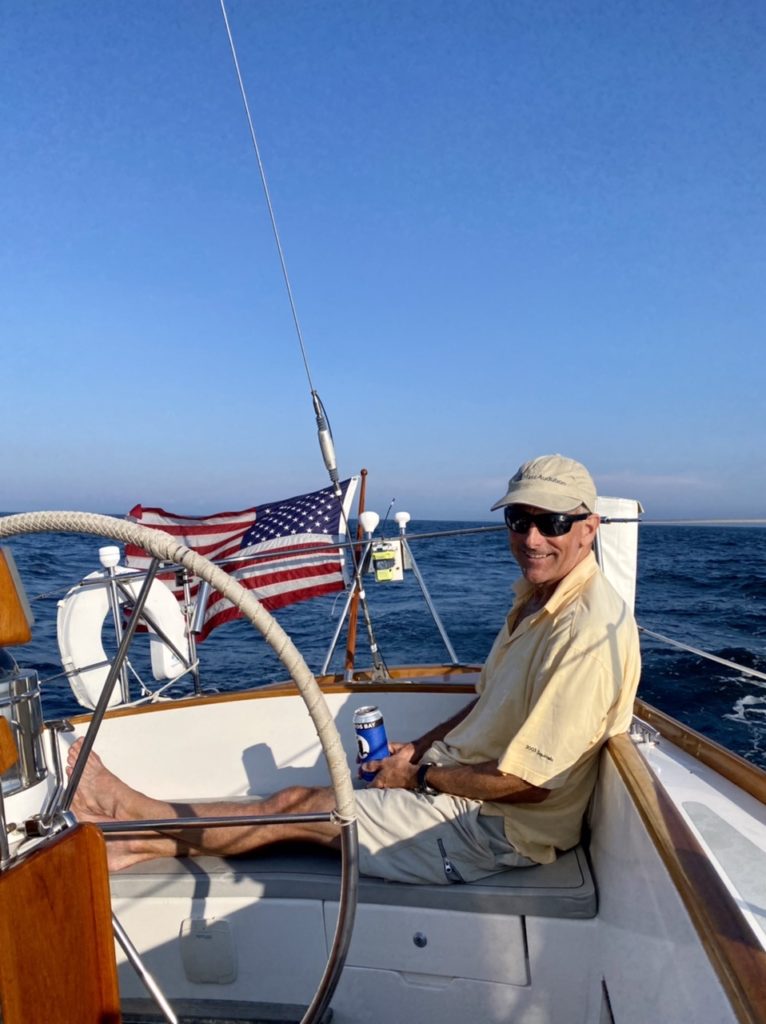When I returned from Everest two and a half months ago, I declared a hiatus on blog posts. However, a recent experience motivates me to share an update.
As background, the time since my return has been great. I gained back the 15 pounds I lost on the mountain and re-started my workout routine. Meanwhile, I allowed myself the summer to figure out what mix of non-profit commitments, for-profit work, and further adventure I should pursue in the years ahead. It has been a relaxing and satisfying time; prioritizing some of Jill’s interests, and having the flexibility to skip a workout here and there to pursue other activities. There is also deep satisfaction in having gotten to the top of that mountain.
Here is a photo Jill took a few days ago as we sailed across Buzzards Bay. It captured my mood perfectly.

The day after this photo was taken, I hopped into our motor dinghy and headed out to the boat to do some routine chores. It was a calm morning, still early, and it was nice to be out in the harbor. After dispensing with the chores, I sat on deck absorbing the beauty. Then I got back in the dinghy, pulled the outboard motor, and headed back to the dock.
It was low tide. I needed to navigate shallow water to get to my usual tie up spot. I did what I frequently do in this situation, turning around to lift the idling motor into the shallow water setting. This moves the propellor to just barely below the waterline. The new motor we bought this year doesn’t raise and lower quite as easily as our old one did, so I had to jiggle the motor to get it to lock into position. As I did this, the motor tiller brushed the side of the dinghy and jerked into full throttle. The dinghy surged forward, then swerved violently to starboard. I felt myself being thrown from the dinghy into the shallow water.
Outboard motors are sold with “kill switches”. These are rubber lanyards intended to be worn around the operator’s wrist, with the other end connected to a switch on the motor. The idea is that, if the operator is inadvertently thrown into the water, the lanyard pulls the switch and immediately shuts off the motor.
These kill switches are designed to avoid one of the most dangerous situations in motor boating. If an operator is thrown overboard with the motor running, the motor jerks immediately to one side and causes the boat to start spiraling in circles. It is almost impossible for a person in the water to get out of the path of an oncoming motor boat, and the rapidly rotating propeller blades, sharp as knives, can easily shred human bodies. This situation is widely known as “the circle of death”. However, few boat operators bother to actually use kill switch lanyards, especially close to shore. The lanyards are mildly cumbersome and the risk of accident is low. Unfortunately, I fall into this category. I was not wearing a lanyard.
I now faced the circle of death. I stood up in waist deep water, turned, and saw the dinghy coming straight at me, full throttle. In the milliseconds available, I had two clear thoughts: “this may be it”, and “must get as low as I can”. The water was shallow and the dinghy was almost on top of me. I submerged as much as possible, my back on the ocean floor, trying to shield my face. The dinghy passed over me, motor screaming, circling hard to the right as it did.
I resurfaced, trying to assess how badly I was hurt, and realized I had to get out of the way of the dinghy’s next pass. I grabbed onto another boat tied to the dock and held it to me as a shield. Eventually the circling dinghy hit a rock, broke out of its spiral, and ran itself onto the rocky beach; motor still on full. My legs were bleeding profusely in multiple places. I kept splashing salt water on them.
It feels a miracle that I escaped serious injury or death. The propellor blades passed over my right thigh, making five parallel cuts. But the propellor was just high enough, and I was just deep enough, that the cuts are shallow. One blade cut more deeply on my left knee, but the cut was clean. As the doctor who stitched me up said, “you are incredibly lucky you aren’t in surgery right now, with us trying to save severed muscles or limbs, or worse”. If the dinghy hadn’t turned exactly when it did, the blades would have hit me in the face.
My cuts will heal in a couple of weeks. For now, the bigger problem is contusions in my legs, caused by the propellor shaft and metal boat bottom slamming into them. Walking is a real challenge. This too should heal soon. I am beyond fortunate.
This really spooked me. It was an incredibly close call. Nothing I have encountered in the mountains compares.
I pride myself in carefully managing risk, in the mountains and on the water. I have spent a lifetime doing so. But I lapsed, and almost paid a severe price. I still can’t believe how lucky I was. It is a fine line we all tread, often not realizing it.
Friends, wear those lanyards, or seatbelts, or whatever. And let us be grateful for every moment we get to inhabit this good earth.

